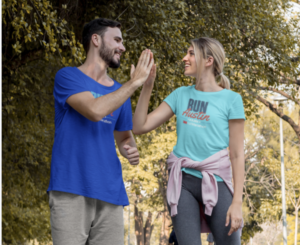Countless Runners Achieve Personal Bests on Iconic Downhill Course
AUSTIN, Texas, January 21, 2024 – Over 6300 runners, representing 46 states and 8 countries, registered for the 30th Anniversary event held on Sunday, January 21st. Athletes traversed the streets of Austin on a course renowned as one of the swiftest 13.1-mile routes in the nation. The day was marked by numerous personal achievements, creating an uplifting atmosphere within the running community.
“Every year surpasses the last, and this year’s milestone 30th event is truly something special. The PR gong was hit some many times that it actually cracked.,” remarked Stacy Keese, co-owner of High Five Events. “Adding to this year’s celebration, we introduced Blaze, our vibrant new mascot, who has quickly captured the hearts of fans. His presence signifies our ongoing commitment to innovation and community spirit as we step into the next 30 years.”
3M Half Marathon embraced favorable running conditions on its 30th Anniversary year. Reflecting on the event, Dr. Keeli Hanzelka Medical Director for Ascension Seton Event Medicine
said “As a runner myself, I find great joy in being part of these events. Our team is dedicated to supporting this vibrant community, and the favorable weather today has been a true blessing for all the runners tackling this distance.
Securing victory in the 2024 3M Half Marathon and setting a new personal best was Jordan West of Waco, TX, crossing the finish line in an impressive 1:05:44. Followed by Rohan Sharma Hernandez of Lucas, TX, claiming second place in 1:07:31, while third place went to Rio Reina of Austin, TX, with a finishing time of 1:07:58.
Former University of Texas runner and Austin local, Katie Watson was the first woman across the line 1:15:44. Following Katy was Emily Merriman of Amarillo, TX at 1:16:32, and Rachel Werking of Elm Grove, WI coming across third at 1:18:31.
Participating couple Joe and Bobbie Jo Cardenas, who were first time participants remarked “Our first 3M half marathon was awesome! Everything was set up perfectly from the beginning to the end. It was a great start for getting ready for the Austin Marathon. It made us feel sure we can keep going with our training. We can’t wait to come back next year to try to beat our time and get to ring the gong!”
The 3M Half Marathon would like to thank the dedicated volunteers, spectators, and all participants who contributed to the event’s success. Special recognition also goes to sponsors and partners, including 3M, Ascension Seton, GU Energy Labs, evamor, EIGHT Beer, Fleet Feet Austin, Nuun Hydration, H-E-B, Favor, SPIbelt, Austin Sports Commission, Super Coffee, Texas Drain Specialists, Life Time, Goodwill Austin, FinisherPix, Austin Police Department, Department of Public Safety, CapMetro, and Travis County EMS. In collaboration with the 2024 3M Half Marathon, 3Mgives generously donated $75,000 to this year’s beneficiary, Finding Home ATX.
Registration for the 31st edition of the 3M Half Marathon is now open with Early Bird pricing of $89 until Thursday, January 31st. The event will be held on January 19, 2025, in Austin, Texas with two days of Health and Fitness Expo on January 17 and 18. Interested exhibitors can register HERE.
About the 3M Half Marathon: The 3M Half Marathon, established in 1995, is one of Austin’s premier running events. With a reputation for its fast and picturesque course, the race attracts runners of all levels from around the world. Organized by High Five Events, the 3M Half Marathon is a celebration of athleticism, determination, and the vibrant running community in Austin, Texas. For more information, visit DownhillToDowntown.com.
About High Five Events: High Five Events is the parent company of the Austin Marathon, Half Marathon & 5k, 3M Half Marathon, CapTex Triathlon and Kerrville Triathlon Festival. With over 150 years of combined experience, the High Five Events team specializes in organizing large-scale events across diverse venues, solidifying their presence on the Inc. 5000 List of Fastest Growing Companies in 2019 and 2020.















